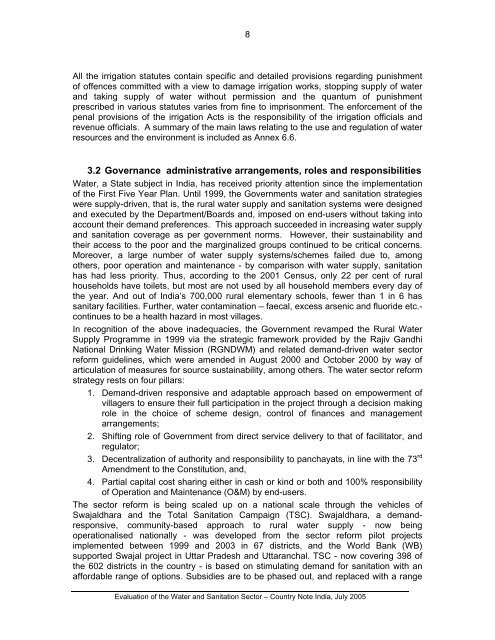Volume 3 - European Commission
Volume 3 - European Commission
Volume 3 - European Commission
You also want an ePaper? Increase the reach of your titles
YUMPU automatically turns print PDFs into web optimized ePapers that Google loves.
8<br />
All the irrigation statutes contain specific and detailed provisions regarding punishment<br />
of offences committed with a view to damage irrigation works, stopping supply of water<br />
and taking supply of water without permission and the quantum of punishment<br />
prescribed in various statutes varies from fine to imprisonment. The enforcement of the<br />
penal provisions of the irrigation Acts is the responsibility of the irrigation officials and<br />
revenue officials. A summary of the main laws relating to the use and regulation of water<br />
resources and the environment is included as Annex 6.6.<br />
3.2 Governance administrative arrangements, roles and responsibilities<br />
Water, a State subject in India, has received priority attention since the implementation<br />
of the First Five Year Plan. Until 1999, the Governments water and sanitation strategies<br />
were supply-driven, that is, the rural water supply and sanitation systems were designed<br />
and executed by the Department/Boards and, imposed on end-users without taking into<br />
account their demand preferences. This approach succeeded in increasing water supply<br />
and sanitation coverage as per government norms. However, their sustainability and<br />
their access to the poor and the marginalized groups continued to be critical concerns.<br />
Moreover, a large number of water supply systems/schemes failed due to, among<br />
others, poor operation and maintenance - by comparison with water supply, sanitation<br />
has had less priority. Thus, according to the 2001 Census, only 22 per cent of rural<br />
households have toilets, but most are not used by all household members every day of<br />
the year. And out of India’s 700,000 rural elementary schools, fewer than 1 in 6 has<br />
sanitary facilities. Further, water contamination – faecal, excess arsenic and fluoride etc.-<br />
continues to be a health hazard in most villages.<br />
In recognition of the above inadequacies, the Government revamped the Rural Water<br />
Supply Programme in 1999 via the strategic framework provided by the Rajiv Gandhi<br />
National Drinking Water Mission (RGNDWM) and related demand-driven water sector<br />
reform guidelines, which were amended in August 2000 and October 2000 by way of<br />
articulation of measures for source sustainability, among others. The water sector reform<br />
strategy rests on four pillars:<br />
1. Demand-driven responsive and adaptable approach based on empowerment of<br />
villagers to ensure their full participation in the project through a decision making<br />
role in the choice of scheme design, control of finances and management<br />
arrangements;<br />
2. Shifting role of Government from direct service delivery to that of facilitator, and<br />
regulator;<br />
3. Decentralization of authority and responsibility to panchayats, in line with the 73 rd<br />
Amendment to the Constitution, and,<br />
4. Partial capital cost sharing either in cash or kind or both and 100% responsibility<br />
of Operation and Maintenance (O&M) by end-users.<br />
The sector reform is being scaled up on a national scale through the vehicles of<br />
Swajaldhara and the Total Sanitation Campaign (TSC). Swajaldhara, a demandresponsive,<br />
community-based approach to rural water supply - now being<br />
operationalised nationally - was developed from the sector reform pilot projects<br />
implemented between 1999 and 2003 in 67 districts, and the World Bank (WB)<br />
supported Swajal project in Uttar Pradesh and Uttaranchal. TSC - now covering 398 of<br />
the 602 districts in the country - is based on stimulating demand for sanitation with an<br />
affordable range of options. Subsidies are to be phased out, and replaced with a range<br />
Evaluation of the Water and Sanitation Sector – Country Note India, July 2005
















